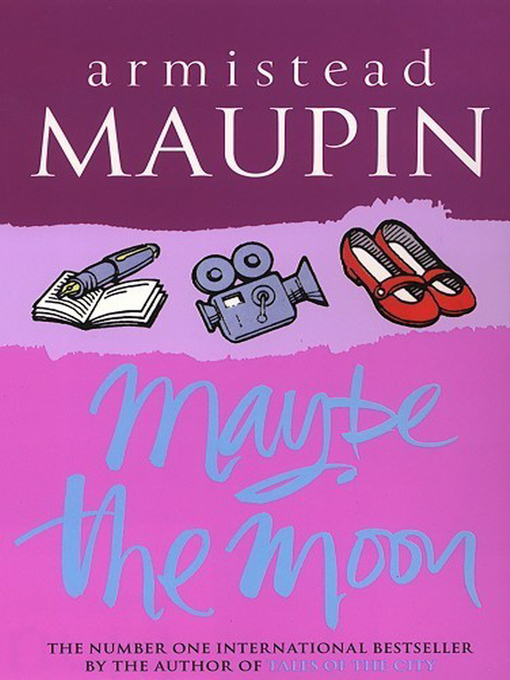Poignant. That's the best way to describe Maybe the Moon. I guess with a title like that, and Armistead Maupin for an author, I should have expected nothing less.
It's a vivid tale about the seamier side of Hollywood and the movie business back in the late 20th century. And it's important to remember that it was published in 1992. Things have changed since then, or at least it is to be hoped they have.
Thirty one inch tall Cadence (Cady) Roth is an actress, or is trying to be, but her one big role was 10 years ago, in the second biggest movie of all time, where she was the legs beneath a rubber and animatronic elf. The character, Mr Woods, turns up in the back yard of a young boy's home, at a time when he needs a friend, and helps the kid through troubled times. Everyone loves the elf, but nobody knows Cady's face. In fact she has been forbidden to discuss her part because the director believes it would spoil the 'magic' of the story. It appears that, far from her talents as an actress, it was her size as the second smallest person in the world that earned her the part. The studio just needed someone small to fit inside the suit.
If you have spotted similarities with 'ET' here that is no surprise. The book was rumoured to be an homage to Tamara de Treaux, a female dwarf who brought that character to life, from inside a heavy and uncomfortable latex-coated contraption. Indeed, Cady spends much of the novel resenting how everyone is unaware that it was a woman inside the Mr Woods costume. As if she didn't have enough emotional problems from dealing with her height, she is also plagued by the constant use of the pronoun 'he' in association with her career. You might also have noticed a recurring theme of 'second best' here too. In fact the book is filled with 'almosts' and 'not quites'. As I said: poignant.
Being Armistead Maupin in the Nineties it is also filled with several politically correct causes. Beyond the central question of acceptance of Cady as a person, rather than a dwarf, there is also the topic of mixed race relationships, when Cady finds herself a tall, good-looking, black boyfriend. And there's a homosexual friend who happens to meet Cady's young boy co-star, now grown-up and cruising in a well-known gay pick-up spot. The child star is making a come-back in an action movie and of course the studio wants to keep his sexual preferences a secret.
The book explores what a bottom-line, image-is-everything place Hollywood can be, or at least was in the 1990s. It's a product of its time, but it's still worth tracking down
It's a vivid tale about the seamier side of Hollywood and the movie business back in the late 20th century. And it's important to remember that it was published in 1992. Things have changed since then, or at least it is to be hoped they have.
Thirty one inch tall Cadence (Cady) Roth is an actress, or is trying to be, but her one big role was 10 years ago, in the second biggest movie of all time, where she was the legs beneath a rubber and animatronic elf. The character, Mr Woods, turns up in the back yard of a young boy's home, at a time when he needs a friend, and helps the kid through troubled times. Everyone loves the elf, but nobody knows Cady's face. In fact she has been forbidden to discuss her part because the director believes it would spoil the 'magic' of the story. It appears that, far from her talents as an actress, it was her size as the second smallest person in the world that earned her the part. The studio just needed someone small to fit inside the suit.
If you have spotted similarities with 'ET' here that is no surprise. The book was rumoured to be an homage to Tamara de Treaux, a female dwarf who brought that character to life, from inside a heavy and uncomfortable latex-coated contraption. Indeed, Cady spends much of the novel resenting how everyone is unaware that it was a woman inside the Mr Woods costume. As if she didn't have enough emotional problems from dealing with her height, she is also plagued by the constant use of the pronoun 'he' in association with her career. You might also have noticed a recurring theme of 'second best' here too. In fact the book is filled with 'almosts' and 'not quites'. As I said: poignant.
Being Armistead Maupin in the Nineties it is also filled with several politically correct causes. Beyond the central question of acceptance of Cady as a person, rather than a dwarf, there is also the topic of mixed race relationships, when Cady finds herself a tall, good-looking, black boyfriend. And there's a homosexual friend who happens to meet Cady's young boy co-star, now grown-up and cruising in a well-known gay pick-up spot. The child star is making a come-back in an action movie and of course the studio wants to keep his sexual preferences a secret.
The book explores what a bottom-line, image-is-everything place Hollywood can be, or at least was in the 1990s. It's a product of its time, but it's still worth tracking down

1 comment:
Sounds interesting and a lot of parallels to ET.
Post a Comment